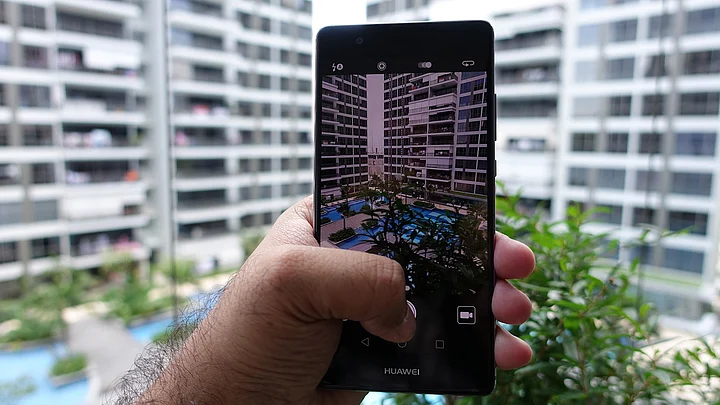It may be one of the largest telecom equipment brands in the world, but ask most folks in India about Huawei smartphones, and you’re likely to be met with a “Who? Why?”
It’s sub-brand, Honor, has done well in the budget segment, but save for the Nexus 6P, Huawei’s been missing from the high-end flagship segment.
However with the dual-camera sporting P9, Huawei wants to move a level up from the Android second-tier and prove it can play with the big boys. It gets a lot of stuff right, but does it go the distance for Huawei in India?
Pros:
- Great build quality and in-hand feel
- Excellent camera, given ideal conditions
- Decent screen
Cons:
- No OIS or 4K video recording
- Performance not top-notch for price
- Low-light camera shots grainy
- Average battery life, lacks fast charging
What’s Good?
For a phone that promises to “reinvent smartphone photography”, more so one sporting a “Co-engineered with Leica” tag (a first for any smartphone), my first
port of call on the P9 was the rear camera.
Make that ‘cameras’, since the P9 packs in a dual-camera setup. We’ve seen dual-cameras for depth sensing in the HTC One M8 previously, but Huawei’s approach is more akin to the Qiku Q Terra’s.
The P9 has two 12-MP Sony sensors, each with f/2.2 lens, but while one is a normal RGB (red green blue) sensor for color, the other is a monochrome sensor which captures only how much light is coming in, without color information.
Sure, this will let you take real monochrome images that have a magical moodiness to them, and since the second sensor captures depth information as well, it even
allows for after-the-shot refocusing, but the real reason Huawei was packed in this second sensor was to drastically help reduce noise. Theoretically, at least.
In use, low light shots weren’t all that I’d hoped for and indoor/low light shots still had noticeable noise levels, results I’d put down to the lack of optical image stabilization and lenses that just aren’t very fast – dual 2.2s compared to the S7’s f/1.7, and the G5’s f/1.8.
Both these factors would allow for a lot more light to hit the sensor and make for much brighter, less noisy images, than the dual-sensor setup manages. A switch to the Pro mode, where you can tweak ISO, Shutter Speed, Exposure Value, AF Mode and Color Balance does help matters immensely, especially in low-light shooting.
Fair to say a lot of folks don’t normally switch to ‘Pro’ mode, but the P9 will entice you to do it more often.
One gets a feeling that the P9 rushed ahead with the dual lens trick to best others who will likely sport dual cameras in the coming months. That said, unless you shoot in very challenging light, the P9 turns out some spectacular shots, with excellent contrast and exposure levels.
Saturation levels are balanced, and the images pack in a good amount of pop and punch, plus there’s a RAW mode for folks who like post-processing their images.
The app’s quite usable too, with easily accessible manual controls and an intuitive way to change the focus point in the photo, probably the best I’ve seen yet. Take the time to master the app and the P9 rewards you with great photos.
The design, while understated, has a lot going for it. A slim all-metal body, curved chamfered edges and a 5.2-inch screen help the P9 sit comfortably in the hand and has an out-and-out flagship feel to it.
The rear fingerprint scanner is snappy and can unlock the phone even when it’s in standby. The India version is a single-SIM device, though you do get a microSD card slot for storage expansion. The buttons have a nice solid feel to them, though for a camera-focused device, a hardware camera button would have been nice.
Turn the device around, and the full-HD IPS LCD screen packs in plenty of detail despite not opting for a quadHD resolution. Brightness levels are satisfactory, and while color reproduction is good as well, you can tweak the color temperature through the settings to suit your personal preferences.
The P9 runs on Android 6.0 with Huawei’s Emotion UI (EUI) on top, and while it includes Marshmallow’s marquee features like Now on Tap, Doze and new app permissions, the UI leans towards simplicity, which is great for some but not for folks looking for massive customizability.
What’s Bad?
Unlike the other Snapdragon-packing flagships, the P9 packs in a Kirin 955 chip, which along with the 3GB of RAM, keeps the phone humming along nicely. Though you
could argue that it’s not a scorcher, performance wise and the difference between the 955 and the 820 devices in terms of app loading times and everyday operations
are at best marginal.
An extra gig of RAM would have future proofed this baby, though. Also, the P9 lacks 4K shooting that’s now become standard in flagships, and the 3,000mAh battery lasts just about a day of heavy use. You do get fast charging support, but the included adapter takes over two hours for a full charge.
Why Buy It?
The P9 has a lot going for it – capable innards, a dual-camera setup that truly delivers in the right conditions and a great design. Trouble is, at the price point
of Rs. 39,999, there’s little room for error – you have the extremely capable OnePlus 3 and Le Max 2 at sub-30K price points.
And a few grand more will get you the S7, which is a considerably better phone on many fronts. The P9 is undeniably impressive, but it just doesn’t deliver a solid value-for-money proposition.
(At The Quint, we question everything. Play an active role in shaping our journalism by becoming a member today.)
